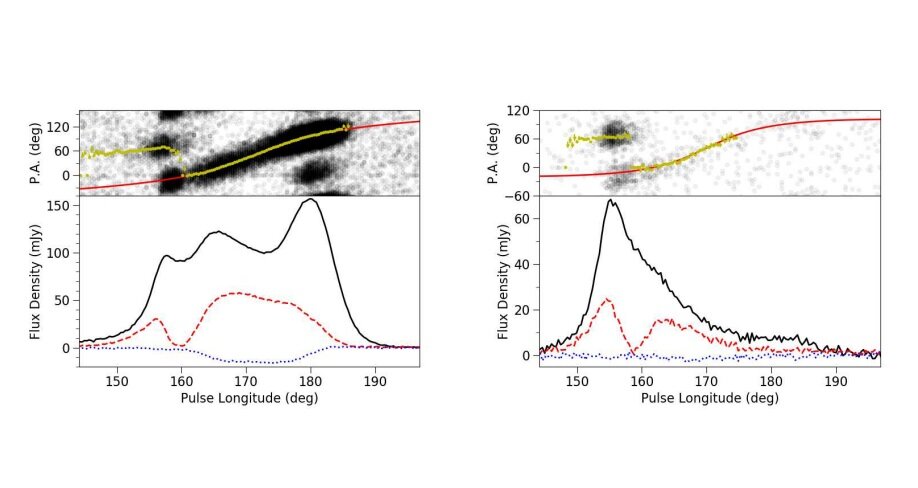
The averaged polarization profiles of normal (left) and abnormal (right) modes for PSR J1326-6700 at 1369 MHz. Credit: Wen et al., 2020.
Using the Parkes 64-meter radio telescope, Chinese astronomers have performed a detailed study of a pulsar known as PSR J1326-6700. The results of this research provide more insights into the mode switching phenomenon observed in this pulsar. The study was published November 11 on arXiv.org.
Pulsars are highly magnetized, rotating neutron stars emitting a beam of electromagnetic radiation. Some of them showcase variability in emission ranging from extremely short bursts like giant pulses to long-term changes in their emission profiles. In some cases, mode changing has been observed in which the emission profile switches between two or more quasi-stable modes of emission.
PSR J1326-6700 is a radio strong pulsar experiencing three pulse modulation phenomena like nulling, mode changing and occasional subpulse drifting. Previous observations have shown that it exhibits two pulse modes: normal and abnormal, with pulse profiles presenting extremely distinct differences. During the abnormal mode, sporadic emission has been observed to appear at the leading edge of the profile lasting for more than a dozen pulses. Meanwhile, the emission from the usual window ceases.
In order to shed more light on the properties of these two modes in PSR J1326-6700 and switching between them, a team of astronomers led by Zhigang Wen of the Xinjiang Astronomical Observatory in China, has analyzed the archival radio data from the Parkes telescope.
"In this paper, by using the archived data observed with the Parkes 64-meter radio telescope at 1369 MHz, we focus on the specific characteristics of normal and abnormal emission modes," the astronomers wrote in the paper.
The study found that PSR J1326-6700 spent 15% of the observational time in the abnormal mode and the rest of the time in the normal mode. The emission height of the abnormal mode was estimated to be around three times higher than that of the normal mode. According to the paper, the occurrence of mode changing in this pulsar appears to be clustered.
The researchers found that in general, the emission comes from three regions of the pulse profile. However, they observed that the emission occasionally weakens at the central and trailing components. This is accompanied by shifts of the leading emission to illuminate the leading edge of the pro?le for less than a minute. Moreover, the study identified a quasi-periodicity in the mode switching of PSR J1326-6700.
The astronomers added that further investigation of PSR J1326-6700 is required in order to fully understand the mode switching phenomenon in this pulsar.
"It is evident that the simultaneous multi-wavelength polarization observations are necessary to offer further insights into the frequency evolution of mode changing in PSR J1326-6700 and to gain a full description of the physical processes driving the changes," the authors of the paper explained.
More information: Wen et al., The mode switching in pulsar J1326-6700, arXiv:2011.05526 [astro-ph.HE] arxiv.org/abs/2011.05526
Editor Tomasz Nowakowski , Phys.org